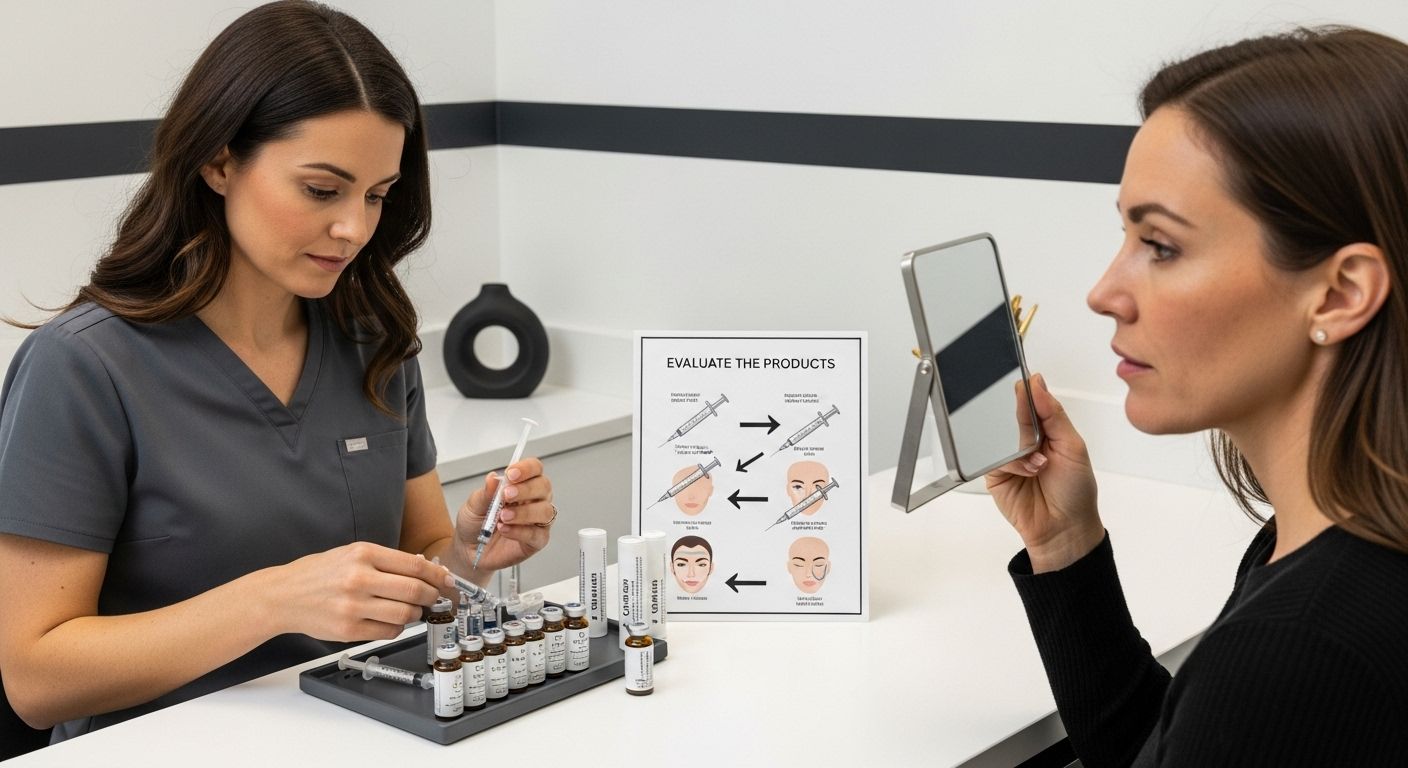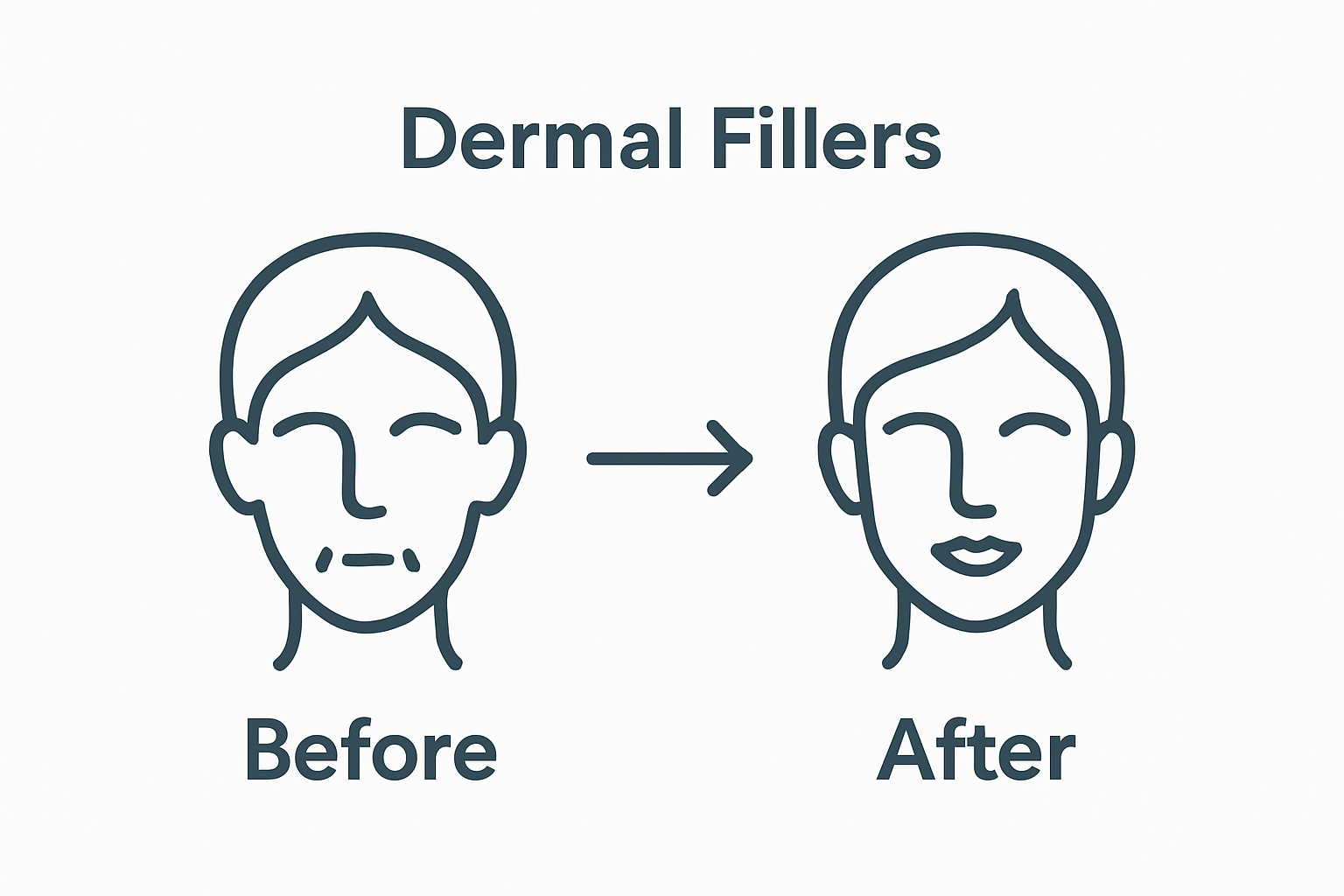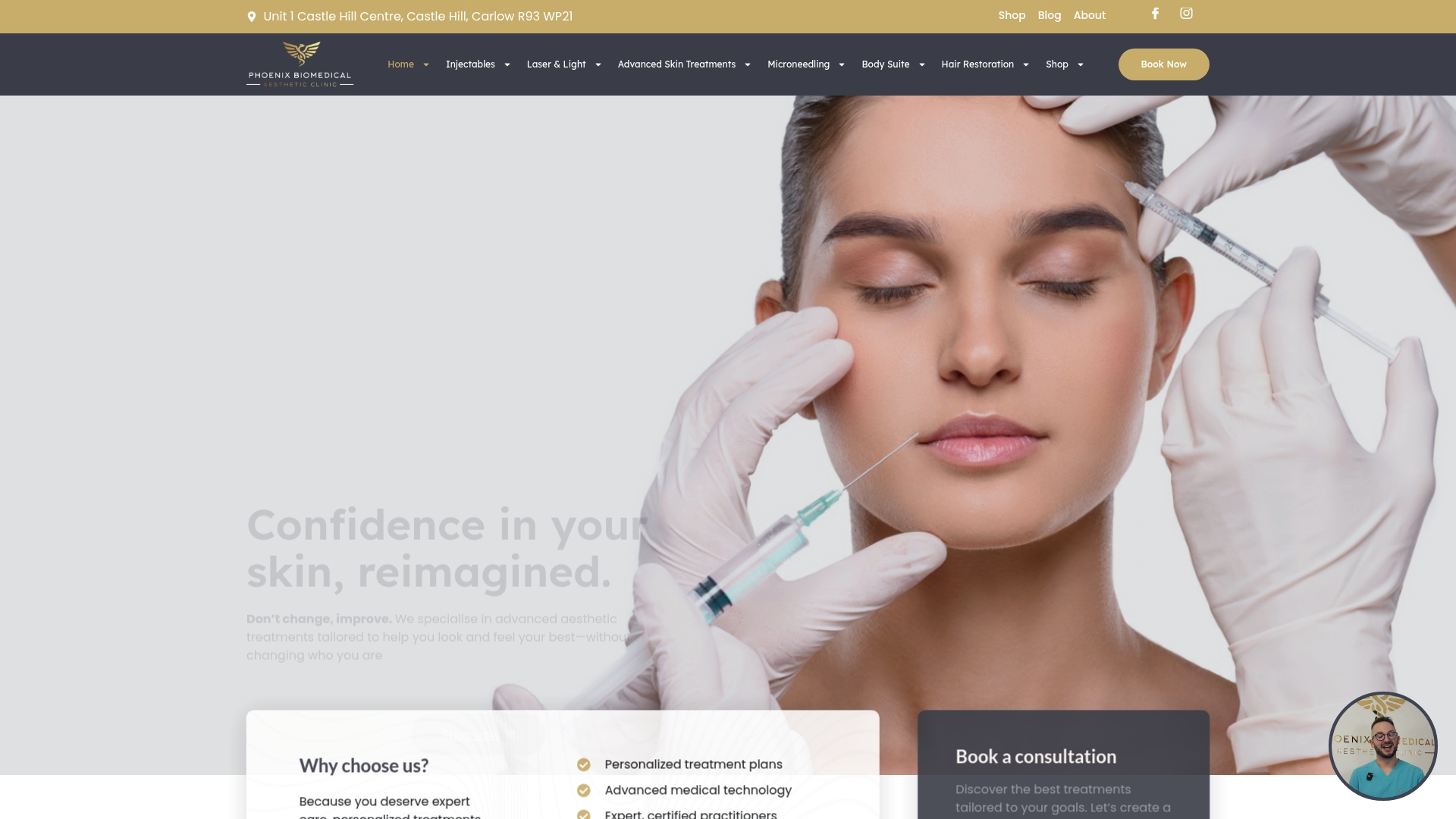How to Choose Dermal Fillers: A Practical Guide for 2025
Deciding to get dermal fillers is not just about chasing trends or smoothing out the odd wrinkle. Huge numbers are making this leap every year and over 4.3 million dermal filler treatments were performed globally in 2022 alone. Surprising, right? Many people believe it is as simple as picking a clinic and showing up, but the real secret lies in how you plan and prepare before the first injection goes anywhere near your skin.
Table of Contents
- Step 1: Identify Your Aesthetic Goals
- Step 2: Research Different Dermal Fillers
- Step 3: Consult With A Qualified Practitioner
- Step 4: Evaluate The Products Available
- Step 5: Discuss Potential Risks And Side Effects
- Step 6: Make An Informed Decision
Quick Summary
| Key Point | Explanation |
| 1. Identify your aesthetic goals | Understand your specific enhancement desires to guide treatment decisions effectively. |
| 2. Research various dermal fillers | Learn about different filler types, properties, and suitable applications for informed choices. |
| 3. Consult a qualified practitioner | Engage with an experienced professional to receive tailored advice aligned with your goals. |
| 4. Evaluate dermal filler products carefully | Assess the composition, duration, and safety profiles of fillers to select the best fit for you. |
| 5. Discuss risks and side effects openly | Be informed about potential complications and ensure transparency with your practitioner during consultations. |
Step 1: Identify Your Aesthetic Goals
Choosing dermal fillers starts with understanding your unique aesthetic objectives. Before diving into treatments, you need a clear roadmap of what you want to achieve with your appearance. This critical first step transforms a generic cosmetic procedure into a personalised enhancement strategy.
Identifying your aesthetic goals requires honest self-reflection and understanding the specific changes you desire. Are you seeking to restore lost volume, smooth fine lines, enhance facial contours, or address asymmetry? Your motivations will directly influence the type of dermal filler and treatment approach.
A comprehensive facial assessment is fundamental to this process. Research from the National Institutes of Health emphasises evaluating facial symmetry, harmony, and ideal proportions. Professional practitioners typically examine multiple factors including:
- Facial structure and bone architecture
- Skin quality and texture
- Areas of volume loss or asymmetry
- Dynamic facial movements
- Ethnicity and individual aesthetic preferences
During your initial consultation, expect a thorough discussion about your aesthetic vision. Be prepared to communicate:
- Specific areas of concern
- Desired outcomes
- Realistic expectations
- Personal comfort levels with potential changes
Understanding that aesthetic goals evolve with age is crucial. What works for a 30-year-old might differ dramatically from a 50-year-old’s requirements. Your chosen dermal filler treatment should complement your natural features, creating subtle, sophisticated enhancements rather than dramatic transformations.
Successful goal identification means being specific yet open-minded. While you might want to address a particular concern, experienced practitioners can offer nuanced recommendations that improve overall facial harmony. The key is collaborative dialogue, where your vision meets professional expertise to create a tailored treatment plan.
Step 2: Research Different Dermal Fillers
Researching dermal fillers transforms an abstract aesthetic desire into a concrete treatment strategy. This critical step involves understanding the complex landscape of injectable options, their unique properties, and potential outcomes. Not all dermal fillers are created equal, and your research will determine the most suitable solution for your specific aesthetic goals.
Research from advanced aesthetic medicine highlights several essential categories of dermal fillers that you must understand. Temporary fillers typically last 6-18 months and offer flexibility for those new to cosmetic treatments. Semipermanent options provide longer-lasting results, while permanent fillers create more sustained changes. Each category presents distinct advantages and potential limitations.
Below is a comparison table of common dermal filler types, highlighting their composition, average duration, and typical treatment areas for easier decision making.
| Filler Type | Common Composition | Average Duration | Typical Treatment Areas |
| Hyaluronic Acid (HA) | Hyaluronic Acid | 6-18 months | Lips, cheeks, under-eyes, lines |
| Calcium Hydroxylapatite | Calcium Hydroxylapatite | Up to 12 months | Cheeks, nasolabial folds |
| Poly-L-lactic Acid | Poly-L-lactic Acid | Over 2 years | Cheeks, temples, lower face |
| Polymethylmethacrylate | PMMA Microspheres | Permanent | Deep wrinkles, facial contours |
| Collagen | Purified Collagen | 3-6 months | Lips, fine lines |
Effective research requires exploring multiple dimensions beyond simple duration. Consider investigating:
- Composition of the filler (hyaluronic acid, calcium hydroxylapatite, poly-L-lactic acid)
- Specific treatment areas (lips, cheeks, under-eye regions)
- Potential side effects and recovery expectations
- Cost range and maintenance requirements
Consult multiple authoritative sources including professional aesthetic journals, board-certified dermatologist websites, and peer-reviewed medical publications. Online forums and patient testimonials can offer valuable insights, but should never replace professional advice. Learn more about advanced filler techniques to understand nuanced application methods.
Your research phase should culminate in a comprehensive understanding of how different fillers interact with your unique facial structure, skin type, and aesthetic objectives. Professional consultations are invaluable during this stage, offering personalised recommendations based on your specific needs and medical history. Remember, thorough research is the foundation of a successful, satisfying aesthetic enhancement journey.
Step 3: Consult with a Qualified Practitioner
The consultation stage transforms your aesthetic research into a personalised treatment blueprint. This is where theoretical knowledge meets professional expertise, bridging the gap between your goals and potential treatment outcomes. A qualified practitioner serves as your strategic partner, offering expert guidance tailored to your unique facial anatomy and aesthetic aspirations.
Comprehensive clinical research emphasises the critical importance of professional assessment in dermal filler treatments. During your consultation, expect a thorough evaluation that goes far beyond superficial recommendations. Experienced practitioners conduct detailed facial analyses, examining bone structure, skin quality, volume distribution, and potential treatment areas with surgical precision.
Prepare for your consultation by gathering critical information. Compile a comprehensive medical history, including:
- Previous cosmetic procedures
- Current medications
- Allergies and skin sensitivities
- Specific aesthetic concerns
- Lifestyle factors that might impact treatment
Your initial consultation is an opportunity for transparent dialogue. Ask direct, specific questions about potential risks, expected outcomes, and recovery processes. A reputable practitioner will provide clear, honest answers and might recommend advanced filler techniques specific to your needs.
Verify the practitioner’s credentials meticulously. Look for board certifications, professional memberships, and a track record of successful treatments. During the consultation, observe their communication style, willingness to address concerns, and ability to create a customised treatment strategy. A successful consultation concludes with a mutual understanding of your aesthetic goals, realistic expectations, and a clear, personalised treatment plan that aligns with your unique facial characteristics.
Step 4: Evaluate the Products Available
Evaluating dermal filler products requires a strategic and analytical approach that goes beyond surface-level comparisons. This critical step transforms your aesthetic vision into a scientifically informed selection process, ensuring you choose a product that aligns perfectly with your unique treatment goals.
Recent clinical research highlights the importance of understanding each product’s distinct characteristics. Dermal fillers are not interchangeable commodities but sophisticated technologies with nuanced properties. You’ll need to assess multiple dimensions beyond simple marketing claims.
Key evaluation criteria should include:
- Composition and molecular structure
- Duration of expected results
- Approved treatment areas
- Potential side effect profiles
- Manufacturing standards and certifications
Consider the rheological properties of each filler – how it flows, integrates with tissue, and maintains structural integrity. Some products excel in specific facial regions, while others provide more versatile applications. Texture, elasticity, and cohesivity are technical but crucial factors that determine natural-looking results.
Financial considerations matter, but should not be the sole deciding factor. Cheaper alternatives might compromise quality or longevity. Professional-grade fillers often provide more predictable outcomes and superior safety profiles. Learn about advanced filler techniques to understand the nuanced differences between product lines.
Successful product evaluation requires patience, thorough research, and collaborative discussions with your aesthetic practitioner. They can provide insider perspectives on product performance, recent technological innovations, and how specific fillers interact with different skin types and facial anatomies. Your goal is not just selecting a product, but finding the perfect aesthetic solution tailored precisely to your individual needs.

Step 5: Discuss Potential Risks and Side Effects
Navigating the landscape of potential dermal filler risks requires a balanced, informed approach. Understanding side effects is not about creating fear, but empowering yourself with comprehensive knowledge. This critical step transforms potential anxiety into strategic preparedness, ensuring you make a fully informed decision about your aesthetic journey.
Comprehensive medical research reveals that while dermal fillers are generally safe, they are not without potential complications. Side effects can range from mild and temporary to rare but serious. Your goal is to understand these possibilities transparently and discuss mitigation strategies with your practitioner.
Common side effects typically include:
- Temporary swelling and bruising
- Mild discomfort at injection sites
- Slight redness or tenderness
- Minor asymmetry
- Short-term skin sensitivity
Rare but serious complications demand serious consideration. These might involve vascular complications, potential tissue damage, or allergic reactions. While statistically uncommon, understanding these risks demonstrates responsible patient preparation. Advanced filler techniques can significantly minimise these risks when performed by skilled practitioners.
Your consultation should involve a comprehensive risk assessment. Ask direct, specific questions about your individual risk factors, including medical history, skin type, and potential interactions with existing health conditions. A reputable practitioner will provide transparent, detailed explanations, helping you understand not just the risks, but the precise probability and potential management strategies.
Successful risk evaluation means reaching a point of informed comfort. You should feel confident in your understanding, with all questions answered and potential concerns addressed.
This table outlines frequent side effects of dermal fillers versus rare but serious complications, helping you discuss and assess risks more effectively with your practitioner.
| Side Effect Category | Examples | Typical Management |
| Common (Mild) | Swelling, bruising, discomfort, redness | Cold compress, resolves in days |
| Moderate | Minor asymmetry, short-term sensitivity | Adjustments, follow-up care |
| Rare (Serious) | Vascular damage, tissue necrosis, allergy | Immediate medical intervention |
 This step is about transforming medical information into personal empowerment, ensuring your aesthetic journey is both safe and satisfying.
This step is about transforming medical information into personal empowerment, ensuring your aesthetic journey is both safe and satisfying.
Step 6: Make an Informed Decision
Making an informed decision about dermal fillers represents the culmination of your comprehensive research and careful consideration. This is not simply a choice, but a strategic personal investment in your aesthetic well-being. The decision-making process requires a delicate balance between emotional desires and objective insights.
Johns Hopkins Medicine emphasizes the importance of aligning personal expectations with realistic outcomes. Your decision should emerge from a holistic understanding of treatment potential, personal goals, and individual physiological characteristics.
Critical decision-making factors include:
- Total treatment costs
- Expected duration of results
- Recovery and maintenance requirements
- Alignment with personal aesthetic goals
- Long-term implications of the chosen treatment
Psychological readiness is equally important as medical preparedness. Reflect deeply on your motivations, ensuring they stem from self-enhancement rather than external pressures. Consider whether the potential results genuinely resonate with your self-perception and confidence levels.
Explore advanced filler techniques to understand the nuanced possibilities of modern aesthetic treatments. A truly informed decision transcends superficial considerations, integrating expertise, personal aspirations, and a comprehensive understanding of potential outcomes.
Verify your decision’s soundness by asking yourself key questions: Does this treatment genuinely serve my aesthetic objectives? Am I comfortable with potential risks and recovery processes? Have I consulted multiple professional perspectives? Your decision is successful when you feel confident, well-informed, and authentically aligned with the chosen treatment pathway.
Ready to Turn Your Dermal Filler Research Into Real Results?
You have invested time in understanding the complex world of dermal fillers, from identifying your aesthetic goals to weighing up the safety, effectiveness, and nuances of different products. Still, the road from research to real transformation can feel uncertain. Questions about personalised care, practitioner skill, and effective treatment planning often create anxiety, leaving you hesitant about your next step. This is where our team at Phoenix Biomedical.ie bridges the gap with clinical precision and care. You gain access to advanced technology, expert consultations, and bespoke recommendations designed around your unique facial characteristics and personal aspirations.

Why risk settling for generic advice? At Phoenix Biomedical.ie, our practitioners deliver scientifically tailored dermal filler treatments using gold-standard techniques. Simply visit our Uncategorized Archives to explore comprehensive guidance or book a consultation to discover how professional, personalised aesthetics can help you reveal your best self. Appointments are filling up for 2025, so act now to put your research into practice and take control of your confidence today.
Frequently Asked Questions
What should I consider when identifying my aesthetic goals for dermal fillers?
You should reflect on specific changes you desire, such as restoring lost volume, smoothing fine lines, enhancing contours, or addressing asymmetry.
How do different types of dermal fillers differ from one another?
Dermal fillers vary by composition (e.g., hyaluronic acid vs. calcium hydroxylapatite), duration of results, and approved treatment areas. Temporary fillers last 6-18 months, while semipermanent and permanent options provide longer-lasting effects.
What should I ask a practitioner during my consultation for dermal fillers?
Be prepared to discuss your aesthetic goals, previous cosmetic procedures, current medications, and any allergies. Ask specific questions about potential risks, expected outcomes, and recovery processes.
How can I evaluate the risks and side effects associated with dermal fillers?
Understanding potential side effects, from mild (swelling, bruising) to rare but serious complications, is essential. Discuss your individual risk factors with your practitioner to ensure informed decision-making.
